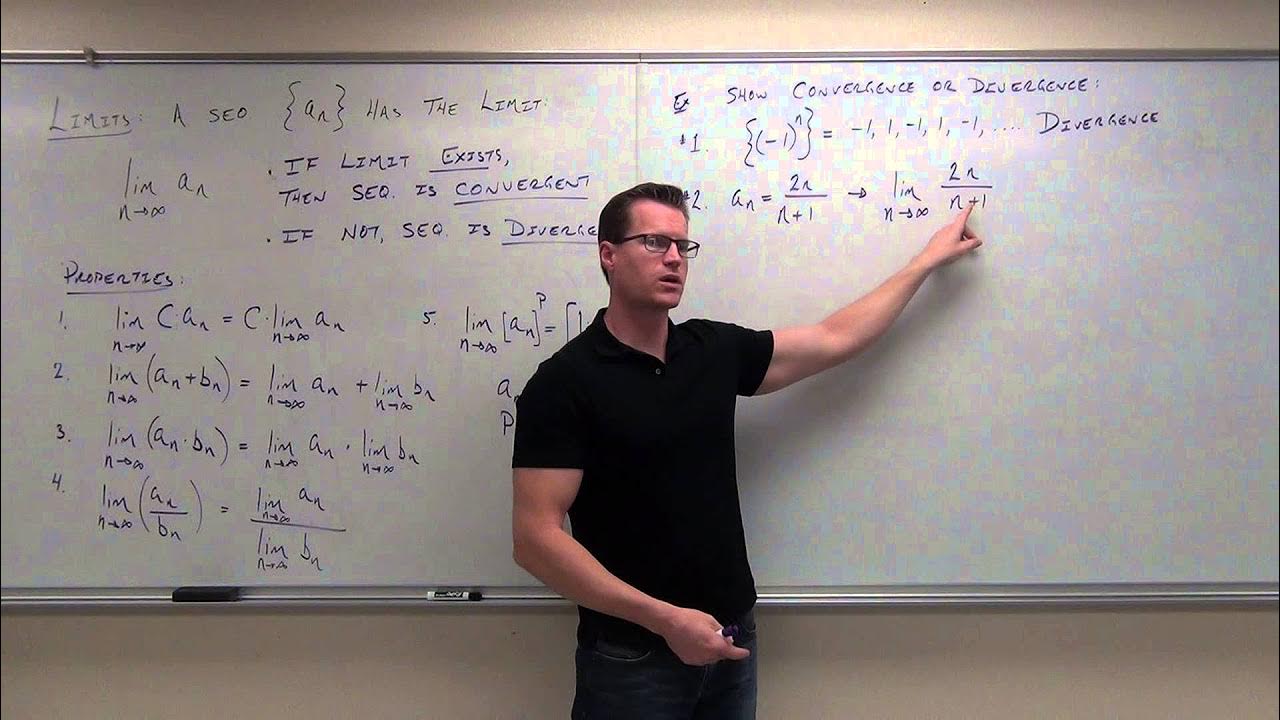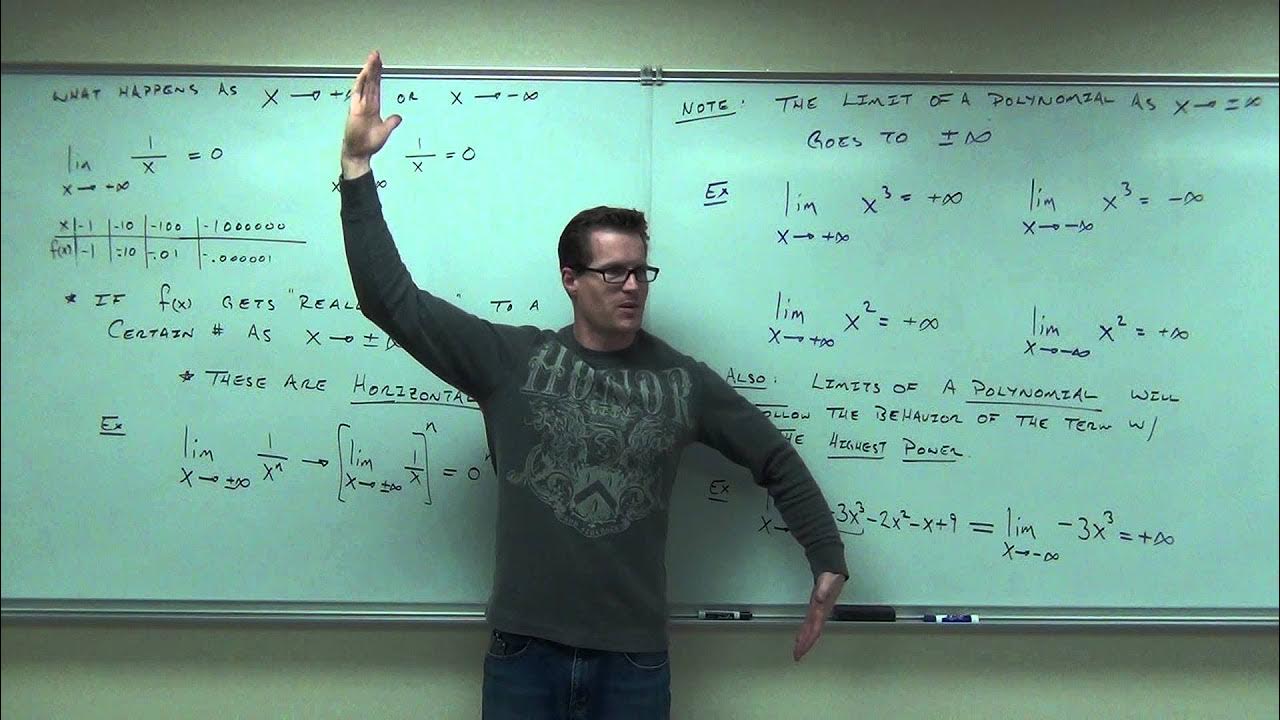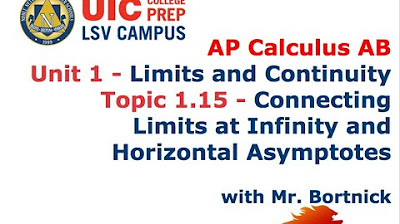Converging and Diverging Sequences Using Limits - Practice Problems
TLDRThis video script delves into the concept of sequence limits, explaining how to determine if a sequence converges or diverges. It illustrates this with various examples, including arithmetic sequences, those involving trigonometric functions, and factorials. The script covers methods such as direct substitution, using limits of constants, applying L'Hopital's rule, and the squeeze theorem. The visual representation of sequences through graphs is also discussed, emphasizing the significance of horizontal asymptotes in determining convergence. The examples provided offer a comprehensive understanding of sequence behavior as n approaches infinity, highlighting the importance of limits in mathematical analysis.
Takeaways
- 📈 The concept of a sequence's limit helps determine if it converges (approaches a specific number) or diverges (increases without bound or oscillates).
- 🔢 For a sequence defined by a_n = 3n + 4, it is an arithmetic sequence with a common difference of 3, and it diverges as it increases towards infinity.
- 📉 The sequence a_n = 1/(3^n) converges to 0 because as n increases, the terms decrease and approach zero, represented graphically by a horizontal asymptote at y=0.
- 📊 To find the limit of a sequence, algebraic manipulation such as factoring or applying l'Hopital's rule may be necessary.
- 📈 The sequence a_n = 8n / (3n - 5) converges to 8/3, as shown by the limit expression and graphical representation with a horizontal asymptote.
- 🌀 The sequence sine(n) diverges because it is a periodic function, oscillating between -1 and 1, and does not approach a specific value as n approaches infinity.
- 📊 For the sequence a_n = cos(1/n), it converges to 1 since the limit of 1/n as n approaches infinity is 0, making the expression cos(0) which equals 1.
- 📈 The squeeze theorem can be used to show convergence of a sequence like sine(n)/n by bounding it between negative one and one divided by n, both approaching zero.
- 📚 The natural log function ln(n^4.5) converges to 0 as n approaches infinity, using l'Hopital's rule to evaluate the limit.
- 🎲 The sequence n * sin(x)^(1/n) converges to 1, as demonstrated by converting the expression to a form suitable for l'Hopital's rule and evaluating the limit.
- 📈 Understanding the behavior of sequences as n approaches infinity is crucial for analyzing their convergence or divergence properties.
Q & A
What is the main topic of the video?
-The main topic of the video is how to find the limit of a sequence to determine if it converges or diverges.
How can you identify if a sequence is arithmetic?
-A sequence is arithmetic if it has a common difference between consecutive terms. For example, the sequence 3n + 4 has a common difference of 3.
What happens to the value of an increasing arithmetic sequence as n approaches infinity?
-The value of an increasing arithmetic sequence will increase without bound and go to infinity as n approaches infinity, resulting in a divergent sequence.
What is the difference between a sequence and a series?
-A sequence is a list of numbers, while a series is the sum of the terms in a sequence. A sequence may converge or diverge, but a series specifically refers to the sum of its terms.
How does the sequence 1/(3^n) behave as n approaches infinity?
-The sequence 1/(3^n) decreases as n increases, and as n approaches infinity, each term approaches zero, indicating that the sequence converges to zero.
What is the limit of the sequence (8n)/(3n - 5) as n approaches infinity?
-The limit of the sequence (8n)/(3n - 5) as n approaches infinity is 8/3, because the n terms in the numerator and denominator cancel out, leaving the constant ratio.
What is the significance of a horizontal asymptote in the graph of a sequence?
-A horizontal asymptote in the graph of a sequence indicates that the sequence converges, as the sequence values approach the same horizontal line as n increases indefinitely.
How does the squeeze theorem help in determining the limit of a sequence?
-The squeeze theorem states that if a function f(x) is bounded between two other functions g(x) and h(x) that have the same limit as x approaches a certain value, then f(x) must also have the same limit at that value. This theorem can be used to show convergence of a sequence when a function is bounded by two others with known limits.
What happens to the sequence sin(n)/n as n approaches infinity?
-The sequence sin(n)/n converges to zero as n approaches infinity because the sine function oscillates between -1 and 1, and dividing by n makes the oscillations less significant as n increases.
What is the limit of the expression (n * sin(1/n)) as n approaches infinity?
-The limit of the expression (n * sin(1/n)) as n approaches infinity is 1. This is because as n approaches infinity, 1/n approaches zero, and sin(0) is equal to 0, making the entire product approach 0 * n, which is 0.
How does the sequence (n! + 1)/n! behave as n approaches infinity?
-The sequence (n! + 1)/n! behaves as infinity as n approaches infinity because the factorial term n! grows without bound, and adding 1 does not change the fact that the limit is unbounded.
Outlines
📈 Understanding Sequences and Their Limits
This paragraph introduces the concept of finding the limit of a sequence to determine its convergence or divergence. It uses the example of an arithmetic sequence defined by the function a_n = 3n + 4 and explains how the sequence increases without bound as n approaches infinity, leading to a divergence. The paragraph also explains the difference between a sequence and a series and emphasizes the importance of understanding limits in the context of sequences.
📉 Analyzing Convergence with Power Functions
The second paragraph discusses the convergence of a power function sequence, a_n = 1/3^n, by calculating its first four terms and their decimal values. It highlights that as n increases, the sequence decreases and approaches zero, indicating convergence. The paragraph further explains the concept using a graphical representation, mentioning both vertical and horizontal asymptotes, and emphasizes that a sequence converges if it follows a horizontal asymptote.
📊 Solving Sequences with Algebraic Manipulations
This paragraph focuses on solving sequences using algebraic steps, specifically for the sequence a_n = 8n / (3n - 5). It demonstrates how to find the limit as n approaches infinity by simplifying the expression and applying the concept that the limit of a constant over n is zero. The paragraph also includes a graphical representation, showing how the function approaches a horizontal asymptote, indicating convergence.
🌀 Exploring Trigonometric Sequences
The fourth paragraph examines trigonometric functions within sequences, starting with the sine function. It explains that since sine oscillates between -1 and 1, the sequence sine n does not have a limit as n approaches infinity and thus diverges. The paragraph then discusses the sequence a_n = cosine(1/n), showing that it converges to 1 as the limit of 1/n is zero and cosine zero equals one. It also introduces the concept of graphing sequences to determine convergence or divergence visually.
🔢 Applying the Squeeze Theorem to Trigonometric Sequences
This paragraph delves into the use of the squeeze theorem to prove the convergence of the sequence sine n / n. It explains that since sine varies between -1 and 1, dividing by n results in a sequence that approaches zero as n approaches infinity. The paragraph also discusses the graphical representation of the function sine x / x, highlighting that it follows the x-axis, indicating a horizontal asymptote at zero and thus convergence.
📚 Advanced Sequence Analysis with L'Hopital's Rule
The sixth paragraph tackles more complex sequences involving natural logs and factorials, using techniques like L'Hopital's rule and properties of logarithms. It explains how to manipulate expressions to find limits, such as converting multiplication to division and simplifying factorials. The paragraph demonstrates that certain sequences converge to specific constants, like the natural log of n to the fourth over 5n converging to zero, while others, like n times sine^(1/n), converge to e. The use of l'Hopital's rule is highlighted to find limits involving indeterminate forms.
Mindmap
Keywords
💡sequence
💡limit
💡convergence
💡divergence
💡arithmetic sequence
💡geometric sequence
💡trigonometric functions
💡horizontal asymptote
💡L'Hopital's rule
💡squeeze theorem
💡factorials
Highlights
The video discusses the concept of finding the limit of a sequence to determine if it converges or diverges.
An arithmetic sequence with a common difference of three is presented as an example, where the sequence increases without bound, diverging to infinity.
The concept of convergence is explained as a sequence approaching a specific number, denoted as 'l'.
A sequence of the form 1 over 3 to the power of n is shown to converge to zero as n approaches infinity.
The difference between a sequence and a series is briefly mentioned, with the focus on sequence convergence.
A sequence involving the function 8n divided by 3n minus five is explored, showing that it converges to eight over three.
Trigonometric functions, such as sine of n, are discussed as divergent sequences because they oscillate between -1 and 1 without converging to a specific value.
The sequence cosine 1 over n is analyzed and found to converge to one as n approaches infinity.
The squeeze theorem is introduced as a method to prove convergence of a sequence, specifically for the sine n divided by n example.
L'Hopital's rule is discussed as a technique to find the limit of a sequence involving factorials and products.
The natural log of n to the fourth over five n is used as an example to demonstrate the application of L'Hopital's rule.
The video emphasizes the use of graphical representation to visually understand the convergence or divergence of sequences.
The sequence n times sine raised to the 1 over n is analyzed using L'Hopital's rule, showing it converges to one.
Factorials are discussed in the context of sequences, with the example of (n plus 1) factorial over n factorial, which diverges.
The sequence (n plus 1) factorial divided by (n plus 2) factorial is shown to converge to zero using simplification and limit properties.
A sequence involving 4n divided by the square root of n squared plus 5 is demonstrated to converge to four.
The video concludes by summarizing the methods for determining if a sequence converges or diverges based on the limit as n approaches infinity.
Transcripts
Browse More Related Video

Worked example: sequence convergence/divergence | Series | AP Calculus BC | Khan Academy

Calculus 2 Lecture 9.1: Convergence and Divergence of Sequences

Geometric Sequences (Precalculus - College Algebra 71)

Calculus 1 Lecture 3.5: Limits of Functions at Infinity

Convergence and Divergence - Introduction to Series

AP Calculus AB - 1.15 Connecting Limits at Infinity and Horizontal Asymptotes
5.0 / 5 (0 votes)
Thanks for rating: